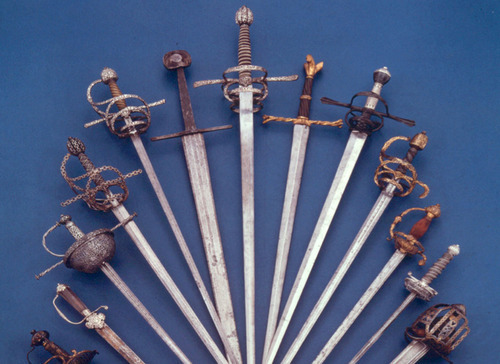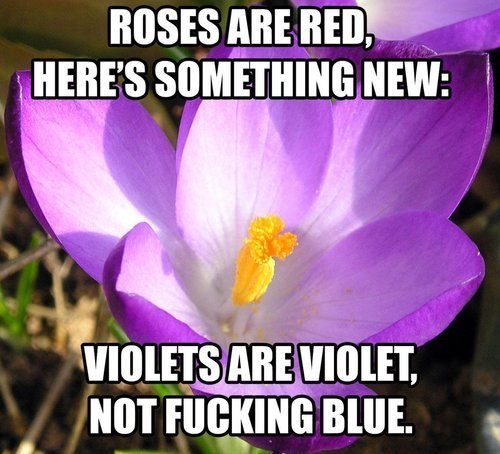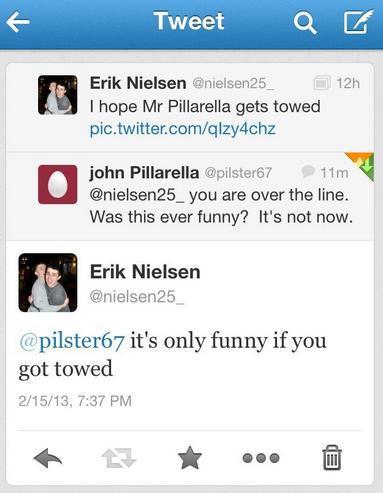Charissa Cotrill's Blog, page 99
February 23, 2013
citadelbloodbeard:
art-of-swords:
Sword Facts & Myths
All...

Sword Facts & Myths
All Medieval swords weighed at least 12 pounds – FALSE
Most Medieval swords weighed around 2.5 lbs - even long hand-and-a-half and two-handed swords weighed less than 4 lbs.
Medieval swords were not sharp - FALSE
Some surviving samples of Medieval swords are still sharp - many are razor-sharp.
All swords should balance within 2” of the guard - FALSE
A sword’s balance should be determined by its function, not an arbitrary standard. Swords intended for cutting often balance 5 or 6 inches from the guard.
Swords were made to cut through armour - FALSE
Period armour was often work- and case-hardened and curved such that it is difficult to hit at a right angle. Late Medieval thrusting swords, even the ones with a reinforced point, were used to thrust into the gaps in armour, not through the plate.
Viking swords were heavier than Medieval swords - FALSE
The Viking sword was a very highly developed sword form. Often the blades were quite thin in cross section, and as a result, were often the same or lighter in overall weight than other similarsized swords.
There is no such thing as the “perfect” sword - TRUE
There are only “perfect” swords for their intended purpose and the tastes of the owner.
A “good” sword should be able to bend past 90 degrees without taking a set - FALSE
Flexibility is only one of the aspects of the steel properties that is important in a sword. Too flexible, and it is inefficient in the thrust and the cut. Too stiff and it is prone to breakage. Most makers are content if a sword will bend to 45 degrees without taking a set.
Real swordfights were just like they are in the movies - FALSE
Swordfights in movies are choreographed for entertainment not authenticity. Edge to edge parries and fancy techniques are designed to heighten drama in a scene. An actual swordfight would be short, brutal and much quieter.
Japanese swords are the sharpest and best swords ever made - FALSE
Japanese swords have many admirable qualities and were well-suited to their intended use, but they are not necessarily sharper or better than a properly designed and sharpened Medieval sword.
Medieval swordmakers were uneducated barbarians - FALSE
It is apparent from even a cursory study of surviving Medieval swords that blademakers and cutlers were highly skilled artisans with a profound understanding of mathematics and proportion.
Not all swords should be as sharp as a razor - TRUE
The sword’s intended purpose is always the guide to use — thrusting swords are not intended for cutting, so some may not even have an edge at all, just a well-defined and reinforced point.
Swords were tempered in urine or blood - FALSE
The steels smelted in Medieval Europe required either clean water or oil for quenching. Urine or blood would not allow a blade to temper properly.
The “blood groove” is on a sword to release pressure in the wound and allow the sword to come back out - FALSE
“Blood groove” as a term is a recent invention — “fuller” is the proper name for the groove or grooves on a sword blade. The purpose of the fuller has nothing to do with “blood” — fullers reduce weight, assist in the proper distribution of mass in a blade, and help make the blade more stiff.
A good sword can cut through a concrete pillar - FALSE
Swords were intended to cut through flesh, clothing, and (in earlier swords) leather or mail armour. They are not intended to cut wood, concrete or metal pillars, even though that is often seen in films.
A sword will fall apart if you don’t clean the tang of the sword - FALSE
The tang of a sword, if properly made and the rest of the sword properly maintained, will not require any maintenance for generations of use.
Japanese folded steel is superior to European sword steel - FALSE
Folding steel was a technique used by Japanese smiths to try to get the best steel they could from very poor ore sources. Folded steel blades are more likely than modern monosteels to have large, unseen inclusions of impurities that may in fact critically weaken a blade. By folding the steel billet many, many times, they achieved a more even distribution of carbon and worked most of the impurities out of the steel. The result is stunningly beautiful, but we have to believe that if a 16th C Japanese smith had access to modern monosteels, he would have switched in a heartbeat.
Pattern-welded steel is superior to mono-steel - FALSE
Like folding steel, pattern-welding was a technique used to try to get the best steel from very poor ore sources. Pattern-welding is the art of hammering together, and then twisting and re-hammering layers of iron (often of varying carbon content). The Celts as far back as the 5th century BC may have made swords by pattern-welding, and this technique was used extensively until at least the end of the 10th century. After this, better, more consistent iron ore was obtainable, and furnace technology improved, making this laborious technique unnecessary. Also like folded steel blades, pattern welded blades are more likely than modern monosteels to have large, unseen inclusions of impurities that may in fact critically weaken a blade.
Swords are just big knives - FALSE
The design of a sword is far more complex than a knife. Flexibility balance and vibration are far more critical in a sword-length blade than in a knife-length blade.
Info source: © 2005 Albion Armorers, Inc.
Photo source: © Royal Armouries
I haven’t even heard most of these myths. People actually think people quenched swords in piss?
Please Reblog this so I can show my mum how many support me becoming female to male gender reassignment.
being-logan:
whoa-hereshecomes:
mayastypewriter:
imdowntherabbithole:
I...
February 22, 2013
missturdle:
On the importance of Magical Girl Heroines &...


On the importance of Magical Girl Heroines & Weaponized Femininity:
Let me start by saying that officially speaking, Sailor Moon is older than I am. I started watching while living in Singapore while I was four, so I definitely came in around the end of Sailor Moon R and watched Sailor Moon S despite the fact that it was played in Japanese with Chinese subtitles. When I moved back to the States, Sailor Moon started being released and aired in sub and dub form and being young and happy to actually hear a language I understood with a show I already liked, I watched the dubs. They’re not the shining star of any animated dub, but I went back several times as I got older, and rewatched the series, in dubs, in subs, all 200 episodes. I changed my self-identified scout, I understood what got cut out of the show, what was censored, I went back and relived my crush on Tuxedo Mask again…and again. In terms of “formative media” Sailor Moon is probably near the top of the list. I still have the sticker book I had when I was 5/6 that has a page dedicated to these magical girls, and they’ve been with me a lot longer than almost anything else, including Harry Potter, Avatar: the Last Airbender, and most other narratives, superhero, fantasy, or otherwise.
When I got the chance last year, I showed one of my girl cousins (who was twelve) the first episode of Sailor Moon. She came back to me about a week or so later and was maybe thirty episodes into the series, bursting with excitement over everything and every one.
I stopped to think about how much that meant to me. Then I thought a little harder. One of my best friends gave me an opportunity to cosplay as Sailor Scouts, and I leapt at the chance. I accidentally stumbled across the newer series Puella Magi Madoka Magica, and marathoned all twelve episodes. Then I made my best friend watch it.
Why does Mahou Shoujo stick with us? The show I loved when I was six is something I love when I’m twenty, and something my cousin who is a tween also loves. For that matter, Puella Magi is, essentially, an update of the classic Magical Girl story, with some genre subversions thrown in. What makes magical girls so important?
Yes this so much THIS
hillarygayle:
counterintuitivefangirl:
quazza:
what if bodies just had random errors like...
counterintuitivefangirl:
quazza:
what if bodies just had random errors like...
February 21, 2013
irkdesu:
IT CAME.
And so did she. #truestorybro #unboxinggasm
wyste:
naamahdarling:
boggletheowl:
The thing is, so many...


The thing is, so many depressed people secretly think this way. It’s a depression mind trick that keeps so many people who need help from seeking it out. I just hope drawing attention to it here, where it’s so clearly stated, might help a few people spot the contradiction in their own minds. Anon, please go get help. Your problems are obviously not insignificant.
Okay, bipolar-depressed person with anxiety issues talking here. So I know what I’m talking about.
OP, you say that you feel like you can’t get help. What you are really saying, though, what I am hearing through my magical internet thought-phone, is that you feel like you don’t deserve help, and/or nobody will help you.
Look, sugar — can I call you that? I’m midwestern. We do that. Sugar, depression is a big, smelly, lying liar who lies. And one of its favorite lies goes like this:
“What makes you so special? There are people out there suffering way more than you, way worse off than you. They deserve help more than you. In fact, since you are a screwup, you probably deserve to suffer. This painful and shitty life is your punishment for being useless. You can’t handle the slightest adversity without folding like a wet noodle. Look at you! Your problems are tiny and you are still pissing and moaning and unable to deal with them. You are a disappointment to the very oxygen you breathe. You are a worthless lump who should never have been brought into this world, and you should immediately apologize to your mother’s vagina and throw yourself into a bear pit.” (I am sorry I even had to type that out. THOSE THINGS ARE NOT TRUE, OP.)
And almost the whole world around us BACKS THAT UP. It tells us to smile more, try harder, that our attitude will change the outcome, that if we believe enough, stay positive enough, set enough goals, we will prevail and do amazing things. And if we don’t, then clearly it’s our fault, and we brought it on ourselves. It gives us no respect when we are having a hard time for seemingly no reason, even when that reason is “my neurotransmitters are all fucked up!” Our culture loves to crap on people with invisible illnesses, and likes to call us pussies. Depression is one of those.
OP, I cannot guarantee that this is what your lying depression liar who lies is telling you, but I bet it sounds awfully familiar.
Your heart knows the truth, though. You feel like you are breaking because you are hurt, and you need help. Only … the lying depression beast is telling you that you aren’t hurt, that it’s nothing, that you’re a wuss. But you are hurting. You know you are. You SAY you are. So don’t listen to the depression beast. Listen to the part of you inside yourself that hurts, because that is the part of you that wants to HELP you. Pain is a signal that something is wrong. The part of you that hurts? That part is telling the truth.
If you go to get help, the doctors and therapists will not tell you your problems are stupid. They will help you. (If they do tell you your problems are stupid, they are asshole jackoff dipshits, and I will help you bury the bodies. But I have never actually had this happen.)
I have never, ever, ever met a person who thought they needed help, and who WANTED help, who did not need it very, very badly. OP, you are one of those people, I guarantee it. And I’ve never met anyone who didn’t deserve help. You deserve help, too.
Here’s a thing: I thought I was a fuckup, and blamed myself for problems, but I hurt so BAD, I knew something was wrong. So I got help, and I worked at it, and I began to see that I was so used to being hurt and fucked up that I had learned not to even see how bad it was! I’d been told for so long, and had then told myself for so long, that it was All My Fault and I Will Never Be a Real Person, that I believed it, and blamed myself for all this pain and suffering and suckiness that was caused by 1) my mental illness and 2) my lack of communication, coping, and life skills caused by a fucked-up upbringing.
OP, neither of those things were my fault! And I don’t know where your sucky situation is coming from, but it’s not your fault if you’re hurting and broken.
I am not sure I’m articulating this well. But seriously, you deserve help. So go for it.
If your problems really are tiny, but they are causing you this much pain? Babydoll, that’s a sign that something is wrong! Not that you’re a big wusswad with a wad of wet newspaper where your backbone should be.
Not being able to deal with tiny shit was one of the first major signs I was sick.
Gratifyingly, it was one of the first ones to improve.
Get help, sugarplum. It won’t be easy. It’s not an easy road. But it’s a hell of a lot easier with some help along the way.
You don’t know me but my ask is open, and I’m not going to tell anyone who you are. I’m not a therapist, but if I can help just by telling you that you are a good person who deserves to be cared for, then I will do that anytime. If it weren’t for folks I didn’t know on the internet doing that for me, I would not be here. Or I would be, but it would be a really bad and unhappy version of me. I would be very sick, sicker than I am. So if I can make a difference, I’d like to.
Flawless.
wilwheaton:
dailydot:
High schooler gets suspended for mocking...
inventrix:
clare-dragonfly:
inventrix:
kendraw:
niknak79:
Ju...

Just a little poetry for you guys…
This is perfect, thank you.
that’s a crocus
Violets are violet. But that’s still a crocus.
Well I wasn’t saying violets are not of the color violet, but since you bring it up…
Etymologically, the word “blue” is present in Old English et al. with a meaning as vague as simply being “light-colored”. The limitations on what hues are considered “blue” are linguistically recent: recent enough that there are still artifacts of the more general usage still embedded in modern culture. A brief look at the Wikipedia category page for “Shades of Blue” illustrates this very well. Even now, the precise line between green and blue, and the precise line between blue and purple, are very poorly defined and not especially useful.
Lastly, while violets are most frequently a shade of purple, they can vary widely in color and are not always the shade meant by the contemporary English word violet (which, as a note, is not even the color represented by that crocus).
The poem describing them as blue is not, in fact, incorrect.
I love you, Trix







